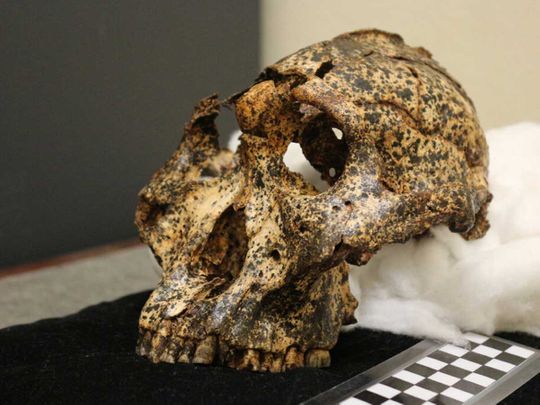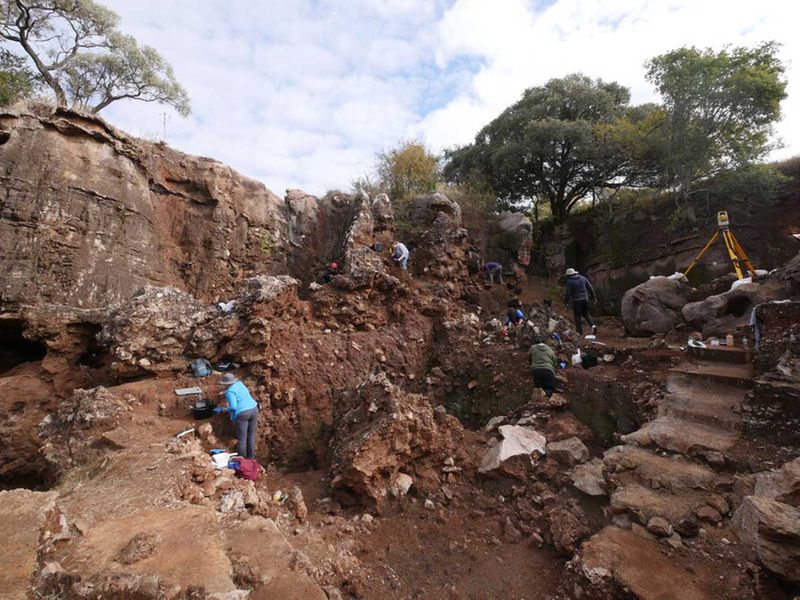
Johannesburg: On Father’s Day in June 2018, Samantha Good was working on an excavation in the Drimolen cave in South Africa’s Cradle of Humankind. She uncovered what appeared to be a canine tooth jutting out from the loose brown sediment. Good kept digging until she found two more teeth and a partial palate, and then alerted her instructors.
“I think I said ‘There’s something interesting happening,’” remembered Good, an undergraduate student studying anthropology at Vancouver Island University in British Columbia who was participating in a field school at the site. “And it was in fact something very interesting.”
Angeline Leece, a paleoanthropologist at La Trobe University in Melbourne, Australia, came to see what Good had found.
“I think my breath stopped for a second,” Leece said. “I looked up at her, and I hadn’t said anything. But she saw my face, and she goes, ‘Yeah, that’s what I thought.’”
Good would eventually learn that she had unearthed a 2-million-year-old skull that belonged to Paranthropus robustus, our large-toothed, small-brained ancient human cousin. It is the earliest and best-preserved specimen found so far of the species, which lived alongside and may have competed for resources with our direct ancestor Homo erectus. And the skull provides the best-known evidence of an ancestor of humanity evolving to adapt to a changing climate, which a team of researchers detailed on Monday in the journal Nature Ecology & Evolution.
Climate shift
Around 2 million years ago, this area in South Africa is believed to have undergone a chaotic climate shift. The regional environment transformed from wetter and more lush conditions to drier and more arid ones. In order for a species like P. robustus to survive in such terrain, it probably would have needed to be able to chew on tough plants. But the specimen found in the cave at Drimolen didn’t seem to fit with what some scientists had previously stated about the human cousin.

They labelled the skull DNH 155 and determined that it belonged to a male. While other skulls had been found at Drimolen, they were primarily female, and this male was smaller than the P. robustus males found at a cave nearby called Swartkrans, which was 200,000 years younger than Drimolen.
Some scientists suggested that since they had found mostly large males in Swartkrans and mostly small females in Drimolen, the size differences could be chalked up to sexual dimorphism, or the physical differences between males and females seen in species, like manes in lions. The argument was that, more or less, only males lived in Swartkrans and only females in Drimolen.
“Now, that didn’t seem right to me,” Leece said. “What it looked like to me instead is that we have males and females in Drimolen, and males and females at Swartkrans, but the Drimolen ones were just overall smaller.”
That day in the cave, she slid her finger beneath the dirt and felt a large sagittal crest on the top of the skull. There were so many bones, the excavators used a special conservator’s glue to adhere the fossils and sediment together to make sure they didn’t lose anything.
Well-preserved
Leece and Andy Herries, a geoarchaeologist also at La Trobe, took the specimen out from the ground in one big block of dirt and bone and delivered it to Jesse Martin, a doctoral student at the university, to painstakingly piece back together.
After a few weeks of gluing bones and sucking up dirt through a straw, Martin revealed the spotted skull that was ensnared in the sediment. DNH 155 was so well-preserved that one of his team members, David Strait, a paleoanthropologist at Washington University in St. Louis, remarked that it had intact nasolacrimal ducts, which is where tears drain. He said to Martin, “This Paranthropus could have cried.”
In addition to being smaller than male P. robustus who lived at Swartkrans, DNH 155’s cranium indicated its chewing muscles were not as strong as theirs. Martin said the differences suggest DNH 155 and the other P. robustus found at Drimolen were smaller not because they were all female, but rather because they were earlier forms of the species belonging to a different population that hadn’t yet been subjected to the environmental pressures that would favor larger sizes and stronger jaw muscles.
“It basically hasn’t become this massive chewing and grinding machine that it becomes later,” Martin said.
Microevolution
The change would have been the result of microevolution, or an evolutionary change occurring within a species. Such a morphological change, the scientists said, was likely the result of P. robustus adapting to that changing climate, with members of the species who were able to get enough nutrition from a change in their food supply surviving, and passing their traits to offspring.
AmElie Beaudet, a paleoanthropologist at the University of Cambridge in England who was not involved in the study, said the conclusions of this study will encourage scientists to reconsider some previous hypotheses about how and why P. robustus specimens that belong to the same species may look so different.
It’s also important that the study’s authors didn’t announce that the find was a new fossil hominin species, said Marcia Ponce de Leon, a paleoanthropologist at the University of Zurich in Switzerland. Instead, they asked “the interesting question of how a known species changed during its evolution.”
Because Good found DNH 155, she was given dedication rights. Fittingly, as it was the “Father’s Day Fossil,” she dedicated it to her dad, Ian.








